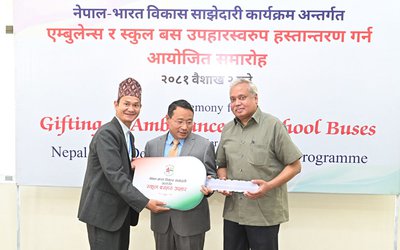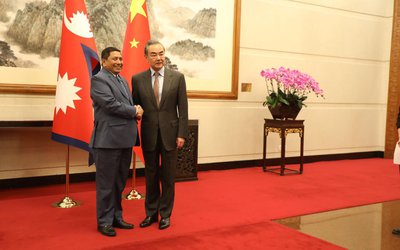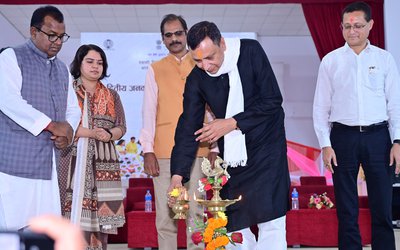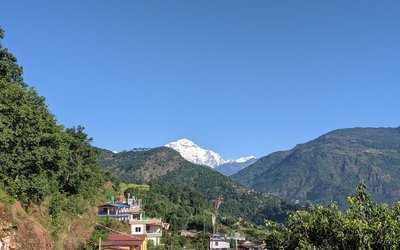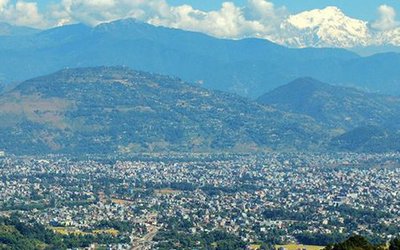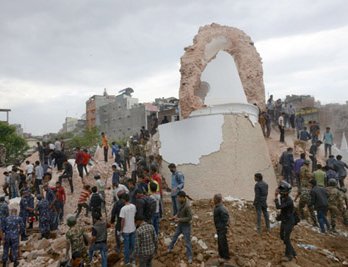
Babulal Tamang, 35, a resident of Bhatte Danda Village of Lalitpur District, 30 kilometers south of the capital, Kathmandu, is at a loss about what he should do now that his house was destroyed by the earthquake.
Father of three children, Babulal, living with his neighbors, manages sustenance for his family from a few packets of noodles and a small amount of money provided by the Village Development Committee.
“We are still sleeping in the open sky with one daily meal,” said Babulal, who is worried that the rainy season is approaching to make his survival more difficult.
Local Development and Federal Affairs Ministry has instructed the local bodies throughout the country to distribute relief to the earthquake affected people.
“At a time when there is no other institution than the Village Development Committee to have direct access and reach to the affected families, the government has sanctioned a budget to the VDCs and municipalities to distribute relief to the victims,” said Dr. Som Lal Subedi, secretary at the ministry. "We have also allocated an additional budget to VDCs. Nepal's development partners have also supported our idea."
Babulal and his neighbors, who are living in the open without any guarantee about their food and shelter,are only a few people in distress at a small area devastated by the quake. Over 4 million others are living in the rural and remote parts of Nepal in a situation similar to that of Babulal. They will face more difficulties once the monsoon starts in Nepal.
The monsoon rains are likely to cause erosion in the hills and mountains which are shaken by the earthquake. Experts have suggested the need to take precautionary measures to prevent the loss of life and property from another calamity soon after the quake.
The present earthquake has exposed Nepal’s weaknesses in disaster management. Talking with this scribe four months ago, Amod Mani Dixit, general secretary of National Society for Earthquake Safety, had highlighted some of these weaknesses in Nepal’s disaster management schemes. They are ringing true now.
Despite making so many progresses in institutional capacity, Nepal is unable to store adequate plastic sheet and tarpaulin. Although Nepal’s friendly countries have provided tarpaulin, it is not enough to meet the demand. People like Babulal are compelled to live in open sky.
“The locals who have been displaced by earthquake are facing more problems due to lack of temporary shelters in view of impending rainfall. Lack of temporary shelters in the district headquarters as well as other areas coupled with the rainfall has made their life more difficult,” said an aid worker.
Nepal Army,Nepal Police and other agencies have built temporary shelters using tents and tarpaulins in limited areas around the district headquarters. However, large numbers of displaced people do not have access to the temporary shelters.
General Secretary of National Society for Earthquake Safety Amod Mani Dixit predicted this long time back with his own personal experiences based on earthquake in India and Pakistan (see his prediction). Even there is scarcity of bamboos to build temporary sheds
As the distribution of relief materials is slow and the government is yet to announce relief packages for reconstruction, millions of people like Babulal are in uncertain situation.
Although Nepal Rastra Bank has already announced a new soft loan package to reconstruct the houses destroyed by earthquake, it will take months to reach such package to the village like Bhattedanda.
Given Nepal’s current situation, the life of millions of rural Nepalis have to face hardships in coming days. Even some farmers lost the paddy and other seeds; it will affect agriculture productivity threatening the food security.
“As the rescue and relief operation is at the phase of completion, we have requested the international rescue forces to leave the country as Nepal’s security forces are capable to handle the remaining tasks,” said Laxmi Prasad Dhakal, spokesperson of Ministry of Home.” Now we are entering the reconstruction and rehabilitation phase.”
With the announcement of Home Ministry, the international rescue teams from 34 countries, including India, have already started to leave the country. However, the relief teams will continue to be there for a certain time to come. “There are no more foreign teams in search and rescue operations,” said Dhakal, spokesperson of Ministry of Home Affairs.
As international group left, earthquake victim like Babulal has to rely on Nepal’s own institutions. In absent of local elected bodies, there will likely to have monopolization of relief distribution on the basis of political parties.
Quake Reconstruction
As the first stage of rescue operation is now complete and relief operation continues, Nepal will have to start next phase of mammoth task for reconstruction and rehabilitation from next round. This is going to be a great opportunity for Nepal.
With support from the international community, Nepal successfully completed the first phase of rescue and relief campaigns. It has now entered into the reconstruction and rehabilitation phase, which is challenging.
Experts have been saying that the recent quake-hit regions of Nepal will only realize sustainable development with the integration of scientific analysis and research.
“I even do not know if the intellectual community has started putting pressure to the planners and funding requesters especially the Planning Commission / Ministry of Finance & Ministry of Foreign Affairs to start preparing a strategy paper to discuss with the donors and investors on the rehabilitation and reconstruction works,” said Gurbar Singh Thapa.
“I still have not read the report on the Damage Assessment Report which should be basis for preparing the strategy paper for Rehabilitation & Reconstruction Phase Draft 1 should be discussed widely before approaching the donors and investors.”
I know from my experience in 1977 as young officers handling finance for a major flood operation of Ministry of Home / Nepal Red Cross Society need of damage assessment report was felt for successfully executing the R & R works because it would help raise funds nationally and internationally.
Amidst the nationwide mobilization to combat the effects of Gorkha earthquake, technical experts are stressing to complete reconstruction planning within the technical framework.
“Nepal needs to start the reconstruction phase forming an experts group to build earthquake resilient buildings. Nepal also needs to map the country in terms of geological state of places,” said Dr. Bishal Nath Uprety, chairman of DipNet and president of Nepal Geological Society. “Use of expert knowledge in preparing the reconstruction plan can reduce the damage.”
“As monsoon is approaching, there is a rush for the reconstruction. If we start the reconstruction without the consultation of experts and scientists, we will invite another disaster with casualty,” said National Society for Earthquake Technology (NSET).
As the government cannot do the reconstruction alone, it needs to involve civil society in the reconstruction. Experts argue that bureaucratic practice of hastily drafting reconstruction plans has not considered the complexity of the quake damage or the already-fragile nature of ecosystems before the quake.
Some of the previous development plans in the quake regions — such as constructing hydropower and multistory buildings-- have been environmentally dangerous. If the reconstruction plan is done quickly, these old approaches might be inevitably adopted.
Nepal’s law stipulates environmental evaluation for individual industrial projects but not general plans for regional development. It has appealed for the development of a rapid response mechanism, allowing general and regional reconstruction plans to go ahead now but be revised when new scientific findings arise on the quake impacts, geological or ecological fragility, and reconstruction failures.
As many geological structures in the quake regions were loosened by earthquake, the coming heavy rain is likely to further damage the loose land.
“Don’t worry; I will bring you a good package for reconstruction. I will request the international community to support in carrying out the reconstruction and rehabilitation work,” said Prime Minister Sushil Koirala, addressing the earthquake victims in Gorkha. “We need strong support from the international community. They need to be here till the completion all these works.”
Prime Minister Koirala’s actions and statements are contradictory. Koirala is seeking international support for reconstruction. By forming a Prime Minister’s Relief Fund, he wants a control over all donations and supports, including the money donated by individuals and communities from around the world.
Although Prime Minister Koirala has softened his stand on centralized fund following public pressure, Nepal Rastra Bank is yet to cancel its earlier circular issued to the commercial banks. The circular directed banks to transfer all the donations deposited for earthquake victims to Prime Minister’s Relief Fund.
“I even do not know if the intellectual communities have started putting pressure to the planners and funding requesters especially the Planning Commission, Ministry of Finance and Ministry of Foreign Affairs to start preparing a strategy paper to discuss with the donors and investors on the rehabilitation and reconstruction works,” said Gurbar Singh Thapa.
“I still have not read the report on the Damage Assessment Report which should be basis for preparing the strategy paper for Rehabilitation & Reconstruction Phase Draft 1 should be discussed widely before approaching the donors and investors.” “I know from my experience in 1977 as a young officers handling finance for a major flood operation of Ministry of Home / Nepal Red Cross Society need of damage assessment report was felt for successfully executing the R & R works because it would help raise funds nationally and internationally. “
Damage and Loss
By writing this story till Thursday morning (May 7), the death toll due to April 25 earthquake has reached 7,675 so far. Similarly, 16,390 people were injured so far, according to the data provided today by the Home Ministry. According to the Ministry. A total of 279,234 houses of general people have been completely damaged and 237,068 partially damaged. This will likely to increase in coming days given the present stage.
International Response
Soon after the major earthquake hit Kathmandu, the international community showed a strong solidarity with Nepal to cope with the situation. Along with Nepal’s southern neighbor India, which landed here first to start the rescue mission; China and United States also joined along with other 34 countries.
United Kingdom announces over 3 billion rupees packages to Nepal. United Nations and European countries came to Nepal with special commitments. United Kingdom announced the package of 750 million rupees, China 660, Canada 410, South Korea 100, Norway 390, EU 320, Bhutan 100, Australia and New Zeeland 450 and Japan 800 million rupees. Morocco, Saudi Arabia and Qatar also announced their support packages for Nepal.
Among the multi-lateral agencies, Asian Development Bank also announced an early package and later offered a big package for reconstruction.
According to United Nations, the quake affected 7.8 million people of 29 districts.Two million population of 11 districts were badly hit. The UN estimates that 41.5 billion rupees will be requiredto bring the normalcy.
Israel, Pakistan, Sri Lanka, Bangladesh, United Kingdom, France, Germany and Japan, TheNetherlands, Bhutan, and Poland came with medical, logistic and relief materials. India, China and the United States also provided helicopters to carry the relief materials.
The Republic of Korea also joined the rescue mission by sending a team and expressing a pledge for financial commitment.Similarly, Qatar government joined in the relief and rescue operation by providing financial support. Embassy of Qatar supported the victims by providing them with relief materials.
Damages of Heritage Sites
According to an estimate, over eighty percent of temples and heritage sites were destroyed by the earthquake, including the famous Dharahara and many popular temples of Kathmandu, Lalitpur and Bhaktapur.
Along with the temples, the quake also devastated the old and traditional villages surrounding the temples. Kirkpatrick had said Nepal had more temples than the people.This quake devastated many of them. The erection of the temples in its old shape and size will cost a lot of money as well as efforts.
Earthquake Warning
Scientists had been predicting a major earthquake and warning people about the risks for a long time, when it finally struckthe Kathmandu Valley, wrecking lives and infrastructure.
For almost two decades, National Society for Earthquake Safety has been in forefront in awareness rising. Executive Director and general Secretary Amod Mani Dixit spares no time to carry campaign that Nepal lies in active seismic zone and it is always vulnerable to major earthquakes. He argued that Nepal needs reconstruction and rebuilding plans looking at the future tremors and quakes.
Just a week before April 25, an international seismology conference warned of a serious quake in Nepal and urged the concerned authorities to take necessary precautions to minimize the damage. For example, Kathmandu’s humanitarian staging area lacks hi-tech systems.
Seismologists and social scientists pointed to the possibility of a repeat of the 1934 quake that flattened the city and killed thousands of people.
In their recently published report onseismic risk assessment and hazard mapping in Nepal, Hemchandra Chaulagain, Hugo Rodrigues, Vitor Silva, Enrico Spacone, and HumbertoVarumhad also called for more precautionary measures.
“Seismic risk in the form of impending disaster has been seen from past records that moderate-to-large earthquakes have caused the loss of life and property in all parts of Nepal. Despite the availability of new data, and methodological improvements, the available seismic hazard map of Nepal is about two decades old,” the report notes.
A study published this month (12 April) in Natural Hazards investigated the structural vulnerability, seismic risk and economic losses owing to future earthquakes in Nepal using the Open Quake software curated by the Global Earthquake Model initiative.
Kathmandu Rose, Everest Sank
According to a newly releasedsatellite data, the deadly earthquake that hit Nepal brought some changes in sharp focus: The city of Kathmandu actually rose three feet after the seismic event.
The data came from European Space Agency’s Sentinel-1A satellite after it passed over the earthquake zone for the first time following the event. Before-and-after comparisons revealed not only that the Nepalese capital rose three feet, but also that Mount Everest had lowered about one inch.
“That’s one of the reasons why Kathmandu has so much damage,” Tim Wright, a geophysicist at the University of Leeds in the United Kingdom, said.
Scientists discovered the vertical shift using a method that generates an image known as an interferogram. The process produces images that have rainbow-colored areas signifying the movement of the ground between the instances each satellite image was taken. Each colorful edge on the ESA’s Nepal interferogram shows around one inch of vertical movement.
The data analysis is expected to be refined in the coming weeks, as researchers investigate the images, further and further information from satellites becomes accessible, the ESA team said.
An initial analysis has revealed a region 75 miles long and 30 miles wide that lifted as much as three feet during the earthquake, with the peak effect seen 10 miles from Kathmandu, despite the fact that the city was considered far from the earthquake’s epicenter.
The nonprofit geosciences group UNAVCO reported that Mount Everest appeared to have shrunk an inch, based on its analysis. Incidentally, some areas of the Himalayas raise nearly half-an-inch every year due to plate tectonics.
Lesson Learned
If Nepal handles the drive properly, it will be a boon for the future of people like Babulal. If it fails, it will be a big bane.
Earthquakes do not kill the people but the infrastructures do. Although Nepal lies in active seismic zone and it has been facing many quakes in the past, what Nepal has not learnt is to live with quakes, making buildings and infrastructures resilient to quakes. Instead of centralization of fund and other issues, the political leaders must come with a vision to transform Nepal. With adequate technical experts, Nepal can change its fate for good in the future.

Keshab Poudel
Poudel is the editor of New Spotlight Magazine.
- ECONOMY: Growth At 3.3
- Apr 16, 2024
- DPM’s SHRESTHA’S CHINA VISIT High Profile, Low Key
- Apr 14, 2024
- Maha Kumbha In Barahkshetra: A Sacred Festival In Sacred Koshi (Kaushiki) River
- Apr 09, 2024
- LOSS AND DAMAGE: Upper Tamakoshi A Case
- Apr 02, 2024
- Helvetas-Nepal’s InElam Promoting Herbal Oil In Sarlahi
- Mar 31, 2024




